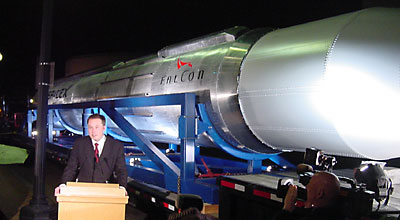The lessons we (should have) learned in 2003<< page 2: lesson 3: suborbital is on the way up Lesson 4: Small is beautifulWhile the established players in the launch industry suffered hardships in 2003, there was innovation in the industry at the lower end. The most notable sign of this has been Space Exploration Technologies (SpaceX), a launch vehicle company established in mid-2002 by Internet entrepreneur Elon Musk. By the end of 2003 the company had unveiled its first completed Falcon 1 launch vehicle, with first launch slated for spring 2004, and also announced plans for a larger vehicle, the Falcon 5, that could fly as soon as 2005. If SpaceX’s pricing holds—$6 million for a Falcon 1 and $12 million for a Falcon 5—the company could shake up the small end of the launch market, and possibly generate new launch demand. The US military has also taken a revived interest in small launch vehicles. In addition to being the first customer for SpaceX’s Falcon 1, it has supported the development of two programs: Responsive Access, Small Cargo, Affordable Launch (RASCAL) and Force Application and Launch from CONUS (FALCON). DARPA selected one startup, Space Launch Corporation, to proceed with further development of RASCAL, an air-launched system for small payloads, in March, and the agency selected nine companies, ranging from startups to aerospace giants, for phase 1 contracts for the small launch vehicle portion of FALCON in November.
However, this interest in small launch vehicles raises the question of just how much demand for these vehicles currently exist. There is a lot of interest in microsatellites that hasn’t yet translated into flown payloads because of the current high costs of launch (or the difficulties, for US payload developers, of exporting satellites to Russia for cheaper launches.) How much demand is truly out there, though, remains an open question. In addition, the Defense Department has focused on the concept of “responsive launch”, the ability to launch payloads on a few days’ notice. What those payloads will be, and whether responsive launch can coexist with low-cost launch, is something both the DoD and vehicle developers will have to grapple with in the next few years. Related articles:
Lesson 5: It takes two to space raceOne of the most highly anticipated events of 2003 was the expected entry of China into the exclusive club of nations that have launched humans into orbit. It was anticipated by some Americans because they felt that the launch of Chinese astronauts would galvanize public opinion in the US, leading to a revived space program and a new race back to the Moon or elsewhere. Of course, that’s not how it turned out. China did indeed send a human into orbit on the Shenzhou 5 flight in October. While Yang Liwei became a hero in China, the flight had little impact on public opinion in the US. Part of that is because the Chinese seemed disinclined to race the US, choosing instead to take a more deliberate, methodical course. After the Shenzhou 5 flight they would only say that Shenzhou 6, the next manned flight, would take place some time in the next two years—hardly a race. In any event, the lack of a heated competition is most likely a good thing: we are still today dealing with the after effects of the first space race with the Soviet Union. Related articles:
Lesson 6: Objects in vision are farther away than they appearAt the beginning of 2003, few people were talking about the vision, or lack thereof, of the US space program. The Columbia accident, and the perception afterwards that NASA was drifting with no set goals or long-range plan beyond the space station, changed all that. By late in the year you could not escape the discussion about the need for a new vision, and no shortage of opinions about what that vision should be. Attention has now turned to the White House, where a new space policy is reportedly in the works, but what that policy will be, and when the President will announce it, remains a mystery. The reality of the situation is that while there may be a broad consensus that NASA needs a new vision, there is no consensus regarding what that vision should be. Proponents of a return to the Moon and a human mission to Mars have stridently argued their cases, with little room for compromise. This raises the potential for dissent within the space activism community should Bush choose one destination over another: how will Mars activists react, for example, if the president announces a return to the Moon? Such dissent could make it harder to press the case for the new policy to Congress and the American people.
In the end, the debate, and the concept of a new vision itself, could be a moot issue. A budget deficit running in the hundreds of billions of dollars a year is putting pressure on portions of the budget, and recent reports suggest that the administration is looking to cut spending on some domestic programs. In addition, 2004 is a presidential election year, and space will get little attention compared to Iraq, the economy, and other far larger issues. Any new vision for NASA will have to fit within those tight constraints. That will be one of the biggest challenges for the space community in 2004, and will offer a whole new set of lessons. Related articles:
Home |
|
